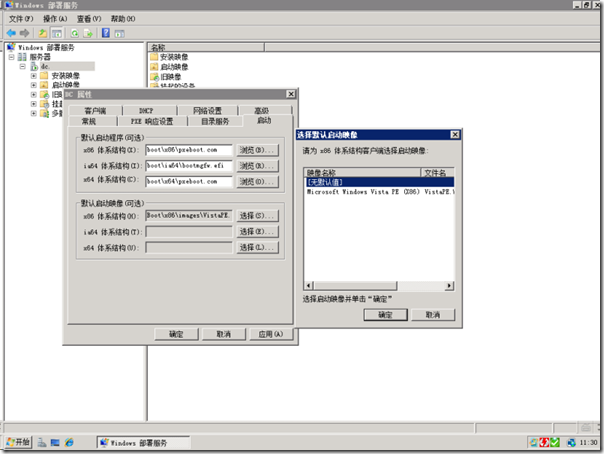目前通过使用 Windows Deployment Services(WDS) 来部署操作系统的 ITPro 越来越多,大部分 ITPro 使用的都是 WDS 的默认配置,在为 ClientComputer 远程安装时,我们需要先启动计算机,之后出现 PXE 引导并获取到 WDS 引导信息后根据提示按下"F12",之后通过选单选择需要引导的启动映像。
那么我们是否会有这样的需要,现在需要部署一批ClientComputer,能够略过按下"F12"这一步骤自动开始开始网络引导,之后能够自动引导进入指定的启动映像呢?其实 WDS 为我们提供了这个非常有用的功能,就在“启动”配置页中,我们可以为 x86、x64 和 IA64 体系结构配置“默认启动程序”及“默认启动映像”。
下面以 x86体系结构为例,默认情况下“默认启动程序”被配置为"bootx86pxeboot.com",那么当ClientComputer在启动计算机时会出现"F12"的提示,我们只有按下"F12"后才能从网络引导并获取到启动映像的信息。如果修改为"pxeboot.n12"那么结果就变成自动开始网络引导获取到启动映像菜单,此时如果你同时配置了“默认启动映像”,如指定了"Microsoft Windows Vista PE (x86)",那么ClientComputer将会自动开始引导这个 Vista PE。
1、进入 WDS 管理器,选中当前服务器并进入其属性;
2、切换到“启动”配置页;
3、在“默认启动程序”配置项中单击"x86 体系结构"后面的“浏览”,根据实际情况选择 NBP;
4、根据需要在“默认启动映像”配置项中单击"x86 体系结构"后面的“浏览”,根据实际情况指定启动映像。
详细的 NBPs 可参考下表:
| NBP | Description | Architecture | Firmware |
| PXEboot.com | (Default) Requires the user to press the F12 key for a PXE boot to continue. | x86-based and x64-based | BIOS |
| PXEboot.n12 | Does not require pressing F12 and immediately begins a PXE boot. | x86-based and x64-based | BIOS |
| AbortPXE.com | Boots the computer by using the next boot item in the BIOS without waiting for a time-out. | x86-based and x64-based | BIOS |
| Hdlscom1.com and Hdlscom2.com | Causes computers that do not support firmware console redirection to display "Press space or F12 for network boot," using console redirection to serial port 1 or 2. Users can proceed with the boot process by pressing either key, or they can exit the boot process by not pressing either key. | x86-based and x64-based | BIOS |
| Hdlscom1.n12 and Hdlscom2.n12 | Causes computers that support firmware console redirection will not display the prompt "Press space or F12 for network boot" and the computer will not wait for user input. | x86-based and x64-based | BIOS |
| Bootmgfw.efi | The EFI equivalent for Bootmgr.exe. In EFI, the choice of whether or not to perform a PXE boot is handled within the EFI shell, and not by the NBP. | x64-based and Itanium-based | EFI |
| Wdsnbp.com | An NBP developed for Windows Deployment Services that serves the following general purposes: 1. Architecture detection 2. Pending computer scenarios 3. PXE referral cases (including use of Dynamic Host Control Protocol (DHCP) options 66 and 67) | x86-based and x64-based | BIOS |



























